
ENGLISH
Introduction
Congratulations on your purchase and welcome to Philips! To
fully benet from the support that Philips oers, register your
product at www.philips.com/welcome.
General description
1 Motor unit
- A Driving shaft
- B Locking arm
- C Control knob
- D Cord storage facility
- E Overload protection button
2 Juicer
- F Cover of pusher
- G Pusher with pre-clean function
- H Feeding tube
- I Lid
- J Sieve
- K Juice collector with (L) spout with drip stop function
- M Pulp container
3 Juice jug lid with integrated foam separator
4 Juice jug
Important
Read this user manual carefully before you
use the appliance and save it for future
reference.
Danger
- Never immerse the motor unit in water or
any other liquid, nor rinse it under the tap.
- Do not clean the motor unit in the
dishwasher.
Warning
- Check if the voltage indicated on the base
of the appliance corresponds to the local
mains voltage before you connect the
appliance.
- Do not use the appliance if the plug, the
mains cord or other components are
damaged.
- If the mains cord is damaged, you must
have it replaced by Philips, a service centre
authorised by Philips or similarly qualied
persons in order to avoid a hazard.
- This appliance can be used by persons
with reduced physical, sensory or mental
capabilities or lack of experience and
knowledge if they have been given
supervision or instruction concerning use
of the appliance in a safe way and if they
understand the hazards involved.
- This appliance shall not be used by
children. Keep the appliance and its cord
out of the reach of children.
- Children shall not play with the appliance.
- Never let the appliance operate
unattended.
- Always disconnect the appliance from the
mains if you leave it unattended or before
you assemble, disassemble or clean it.
- Do not use the appliance if the sieve or the
lid is damaged in any way or shows visible
cracks and contact the nearest Philips
service centre.
- Never reach into the feeding tube with your
ngers or an object while the appliance
is operating. Only use the pusher for this
purpose.
- Do not touch the small cutting blades in
the base of the sieve. They are very sharp.
- Do not insert other items than fruits,
vegetables or the pusher into the feeding
tube.
- Always place and use the appliance on a
dry, stable and level surface.
- To ensure that the appliance stands stably,
keep the surface on which the appliance
stands and the bottom of the appliance
clean.
- Do not eat the pulp or use for preparing
dishes.
- This appliance is intended for household
use only.
Caution
- Do not hold the appliance by the locking
arm when you carry it.
- Always unwind the power cord totally from
the cord storage area before use.
- Never use any accessories or parts from
other manufacturers or that Philips does
not specically recommend. If you use
such accessories or parts, your guarantee
becomes invalid.
- Make sure all parts are correctly assembled
before you switch on the appliance.
- Only use the appliance when the locking
arm is in locked position.
- Before you disassemble the appliance and
before you clean it, set the control knob to
o position and remove the plug from the
wall socket. Then lower the locking arm to
unlocked position.
- Only lower the locking arm to unlocked
position after you have switched o the
appliance and the sieve has stopped
rotating.
- Always unplug the appliance after use.
- Noise level: Lc = 78 dB(A).
Safety feature
This appliance is tted with a safety feature which safeguards
against overheating due to excessive loads. In case of
overheating, the juicer automatically activates the overload
protection and switches itself o. If this occurs, set the control
knob to 0, unplug the appliance and let it cool down for 15
minutes. Remove the juice jug and detach the lid, the juice
collector and the pulp container and then press the overload
protection button on the bottom of the motor unit.
Electromagnetic elds (EMF)
This Philips appliance complies with all applicable standards
and regulations regarding exposure to electromagnetic elds.
Before first use
Thoroughly clean the parts that come into contact with food
before you use the appliance for the rst time (see chapter
‘Cleaning’).
Note
- Always check the sieve before use. If you detect any cracks
or damage, do not use the appliance.
- Make sure the locking arm is locked into position.
Using the appliance
Juicing
You can use the juicer to produce fruit, vegetable and green
juice.
Tips
- Do not operate the juicer for more than 60 seconds at
a time when you juice heavy loads and let it cool down
suciently afterwards.
- Before you start juicing make sure that the spout is in
correct juice position, the opening of the spout should point
downwards.
- To avoid splashing of juice, place the juice jug with properly
assembled juice jug lid below the spout.
- Turn the control knob to setting 1 (low speed) or 2 (normal
speed).
- Speed 1 is especially suitable for soft fruits and vegetables
such as watermelons, grapes, tomatoes and cucumbers.
- Speed 2 is suitable for all other kinds of fruit and vegetables
such as apples, carrots and beetroots.
Note
- Always switch on the device and be sure it is running at full
speed before you insert fruits or vegetables into the feeding
tube.
- Do not exert too much pressure on the pusher, as this could
aect the quality of the end result. It could even cause the
sieve to come to a halt.
- Never insert your ngers or an object into the feeding tube.
- If the pulp container becomes full during use, switch o the
appliance and detach the lid and the juice collector. Then
carefully remove the pulp container and empty it.
- For optimal performance clean the unit (lid, sieve, pulp
container) after each jug of juice.
Drip Stop
- After you have processed all ingredients and the juice ow
has stopped, turn the spout clockwise by about 120° to
activate the drip stop function.
Empty the pulp container
Note: When the pulp container has reached its maximum
capacity, pulp ends up in the juice collector, lid and in the
juice.
If the pulp container becomes overlled, the appliance may
become blocked. When this occurs, switch o the appliance
and remove the pulp from the pulp container. Let the appliance
cool down for 15 minutes and press the overload protection
button on the bottom of the motor unit to reset.
The transparent pulp container helps you to see when the pulp
container is full. Also check the level indication on the juice jug.
When the pulp reaches the level of the juice collector, the pulp
container needs to be emptied.
Tips
Preparations
- Use fresh fruit and vegetables, as they contain more juice.
Pineapples, beetroots, celery stalks, apples, cucumbers,
carrots, spinach, melons, tomatoes, oranges and grapes are
particularly suitable for processing in the juicer.
- The juicer is not suitable for processing very hard and/or
brous or starchy fruits or vegetables such as sugar cane.
- Leaves and leaf stalks of e.g. lettuce can also be processed
in the juicer. To get most out of your leafy greens, roll them
up before juicing and juice the greens in-between hard
fruits like apples or carrots.
- Remove stones from cherries, plums, peaches, etc. You do
not have to remove cores or seeds from fruits like melons,
apples and grapes.
- When you use the juicer, you do not have to remove thin
peels or skins. Only remove thick peels that you would
not eat, e.g. those of oranges, pineapples, kiwis, melons,
pomegranates and uncooked beetroots.
- When you prepare apple juice, take into consideration that
the thickness of the apple juice depends on the kind of
apple you use. The juicier the apple, the thinner the juice.
Choose a kind of apple that produces the type of juice you
prefer.
- If you want to process citrus fruits with the juicer, remove the
peel as well as the white pith. The white pith gives juice a
bitter taste.
- Fruits that contain starch, such as bananas, papayas,
avocados, gs and mangoes are not suitable for processing
in the juicer. Use a food processor, blender or hand blender
to process these fruits.
- To extract the maximum amount of juice, always press down
the pusher slowly.
Serving
- Drink the juice immediately after you have extracted it.
- If you want clear juice without a foam layer, put the lid
with integrated foam separator on the juice jug. If you
want cloudy juice with a foam layer, remove the lid with
integrated foam separator from the juice jug and stir the
juice before you pour it in a glass.
- Apple juice turns brown very quickly. To slow down this
process, add a few drops of lemon juice.
- When you serve cold drinks, add a few ice cubes.
Healthy recipe
Orange carrot ginger juice
Ingredients:
- 1kg carrots
- 20g ginger
- 4 oranges
- 1 tbsp olive oil
- 1 large fresh mint sprig (optional garnish)
1 Peel the oranges.
2 Process the carrots, ginger and oranges in the juicer.
Note: This appliance can process ginger (in pieces of 3x3 cm)
for 1 minute.
3 Add a tablespoon of olive oil and a few ice cubes to the
juice.
4 Mix well.
5 Pour the juice into a glass.
Tip: Add a fresh mint sprig to your glass as an optional garnish.
Cleaning
Never use scouring pads, abrasive cleaning agents or
aggressive liquids such as alcohol, petrol or acetone to clean
the appliance.
The appliance is easier to clean if you do so immediately after
use.
To keep your kitchen clean, all detachable parts (pulp
container, juice collector, sieve and lid) can be carried to the
sink in one go.
Tip: Use a sponge to clean the sieve.
Pre-clean function
When you use the pre-clean function, the lid and the sieve are
rinsed with water.
Use speed 2 for the pre-clean function to achieve the best
results.
Use the pre-clean function:
- To make the juicer easier to clean.
- To rinse the juicer when you switch to a dierent fruit or
vegetable and want to avoid mixing avours.
- To dilute the juice with water and catch even the last drop of
juice.
Storage
To store the cord, wind it round the cord storage facility in the
base of the appliance.
Caution: Do not hold the appliance by the locking arm or
spout when you carry it.
Ordering accessories
To buy accessories or spare parts, visit
www.shop.philips.com/service or go to your Philips dealer.
You can also contact the Philips Consumer Care Centre in
3
4
1
2
10
11
120°
12
1
2
3
6
4
7
8
9
5
HR1915
HR1916
HR1917
4203 064 65091 Bwww.philips.com
Register your product and get support at
www.philips.com/welcome
Always there to help you
A
F
G
H
I
J
K
L
M
B
C
E
D
c
a
b
d
1
2
3
4
your country (see the worldwide guarantee leaet for contact
details).
Recycling
- This symbol means that this product shall not be
disposed of with normal household waste (2012/19/
EU).
- Follow your country’s rules for the separate
collection of electrical and electronic products.
Correct disposal helps prevent negative consequences for
the environment and human health.
Guarantee and support
If you need information or support, please visit
www.philips.com/support or read the separate worldwide
guarantee leaet.
DEUTSCH
Einführung
Herzlichen Glückwunsch zu Ihrem Kauf und willkommen
bei Philips! Um den Support, den Philips bietet, vollständig
nutzen zu können, registrieren Sie Ihr Produkt unter
www.philips.com/welcome.
Allgemeine Beschreibung
1 Motoreinheit
- A Antriebsachse
- B Verriegelungsarm
- C Drehschalter
- D Kabelaufwicklung
- E Überhitzungsschutztaste
2 Entsafter
- F Abdeckung des Stopfers
- G Stopfer mit Vorreinigungsfunktion
- H Einfüllönung
- I Deckel
- J Sieb
- K Saftauangschale mit (L) mit Ausgießer mit Tropf-Stopp-
System
- M Fruchteischbehälter
3 Deckel der Saftkanne mit integriertem Schaumlter
4 Saftbehälter
Wichtig!
Lesen Sie diese Bedienungsanleitung vor
dem Gebrauch des Geräts aufmerksam
durch, und bewahren Sie sie für eine spätere
Verwendung auf.
Achtung!
- Tauchen Sie die Motoreinheit niemals in
Wasser oder andere Flüssigkeiten; spülen
Sie sie auch nicht unter ießendem
Wasser ab.
- Reinigen Sie die Motoreinheit nicht im
Geschirrspüler.
Achtung
- Prüfen Sie vor Inbetriebnahme, ob die
Spannungsangabe an der Unterseite des
Geräts mit der örtlichen Netzspannung
übereinstimmt.
- Benutzen Sie das Gerät nicht, wenn
der Netzstecker, das Netzkabel oder
ein anderes Teil des Geräts defekt oder
beschädigt ist.
- Um Gefährdungen zu vermeiden, darf
ein defektes Netzkabel nur von einem
Philips Service-Center, einer von Philips
autorisierten Werkstatt oder einer ähnlich
qualizierten Person durch ein Original-
Ersatzkabel ersetzt werden.
- Dieses Gerät kann von Personen mit
verringerten physischen, sensorischen oder
psychischen Fähigkeiten oder Mangel an
Erfahrung und Kenntnis verwendet werden,
wenn sie bei der Verwendung beaufsichtigt
wurden oder Anweisung zum sicheren
Gebrauch des Geräts erhalten und die
Gefahren verstanden haben.
- Dieses Gerät sollte nicht von Kindern
verwendet werden. Halten Sie das
Gerät und das Netzkabel außerhalb der
Reichweite von Kindern.
- Kinder dürfen nicht mit dem Gerät spielen.
- Lassen Sie das eingeschaltete Gerät
niemals unbeaufsichtigt.
- Trennen Sie das Gerät immer von
der Stromversorgung, wenn Sie es
unbeaufsichtigt lassen und bevor Sie es
zusammensetzen, auseinandernehmen
oder reinigen.
- Benutzen Sie das Gerät nicht, wenn
das Sieb oder der Deckel in irgendeiner
Weise beschädigt ist oder sichtbare Risse
aufweist, und wenden Sie sich an ein
Philips Service-Center in Ihrer Nähe.
- Greifen Sie unter keinen Umständen
bei laufendem Gerät mit der Hand oder
einem Gegenstand in die Einfüllönung.
Verwenden Sie dazu nur den Stopfer.
- Vermeiden Sie jede Berührung mit den
kleinen Schneidemessern am Boden des
Siebs. Diese sind sehr scharf.
- Stecken Sie keine anderen Gegenstände
in die Einfüllönung außer Obst, Gemüse
oder den Stopfer.
- Verwenden Sie das Gerät immer auf einer
trockenen, stabilen und ebenen Unterlage.
- Halten Sie die Arbeitsäche, auf der das
Gerät steht, und die Unterseite des Geräts
sauber, damit es nicht rutschen kann.
- Essen Sie nicht das Fruchteisch, und
verwenden Sie es nicht zur Vorbereitung
von Gerichten.
- Dieses Gerät ist nur für den Gebrauch im
Haushalt bestimmt.
Vorsicht
- Tragen Sie das Gerät nicht am
Verriegelungsarm.
- Wickeln Sie das Kabel vor dem Gebrauch
immer ganz von der Kabelaufbewahrung
ab.
- Verwenden Sie nie Zubehör oder Teile,
die von Drittherstellern stammen bzw.
nicht von Philips empfohlen werden. Wenn
Sie diese(s) Zubehör oder Teile verwenden,
erlischt Ihre Garantie.
- Prüfen Sie, bevor Sie das Gerät einschalten,
ob alle Teile korrekt zusammengesetzt sind.
- Verwenden Sie das Gerät erst dann, wenn
sich der Verriegelungsarm in gesperrter
Position bendet.
- Bevor Sie das Gerät auseinandernehmen
oder reinigen, stellen Sie den Drehschalter
auf die Aus-Position, und ziehen Sie den
Netzstecker aus der Steckdose. Schieben
Sie dann den Verriegelungsarm in die
entsperrte Position.
- Entsperren Sie den Verriegelungsarm erst,
nachdem Sie das Gerät ausgeschaltet
haben und das Sieb zum Stillstand
gekommen ist.
- Ziehen Sie nach jedem Gebrauch den
Netzstecker aus der Steckdose.
- Geräuschpegel: Lc = 78 dB(A)
Sicherheitsfunktion
Dieses Gerät ist mit einer Sicherheitsfunktion ausgestattet,
die vor Überhitzen aufgrund zu hoher Belastung schützt.
Bei Überhitzung aktiviert der Entsafter automatisch den
Überhitzungsschutz und schaltet sich aus. Wenn dies der
Fall ist, stellen Sie den Drehschalter auf 0, ziehen Sie den
Netzstecker aus der Steckdose, und lassen Sie das Gerät
15 Minuten lang abkühlen. Entfernen Sie den Saftbehälter,
nehmen Sie den Deckel, die Saftauangschale und den
Fruchteischbehälter ab, und drücken Sie dann die Taste für
den Überlastungsschutz unten an der Motoreinheit.
1/2


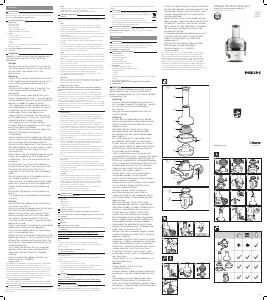

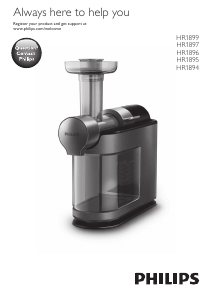
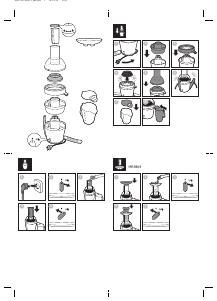
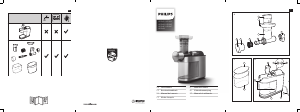
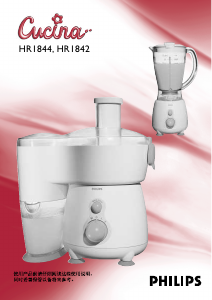
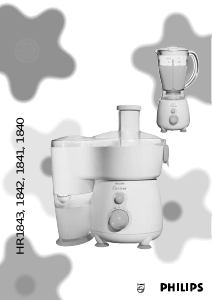
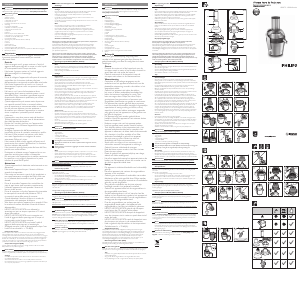

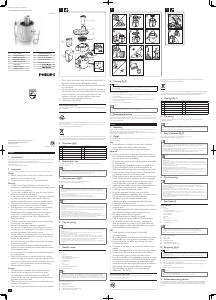
Praat mee over dit product
Laat hier weten wat jij vindt van de Philips HR1916 Sapcentrifuge. Als je een vraag hebt, lees dan eerst zorgvuldig de handleiding door. Een handleiding aanvragen kan via ons contactformulier.